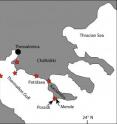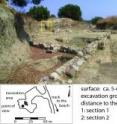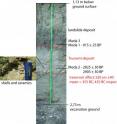Warning signs from ancient Greek tsunami
Related images
(click to enlarge)
n the winter of 479 B.C., a tsunami was the savior of Potidaea, drowning hundreds of Persian invaders as they lay siege to the ancient Greek village. New geological evidence suggests that the region may still be vulnerable to tsunami events, according to Klaus Reicherter of Aachen University in Germany and his colleagues. The Greek historian Herodotus described the strange retreat of the tide and massive waves at Potidaea, making his account the first description of a historical tsunami. Reicherter and colleagues have added to the story by sampling sediments on the Possidi peninsula in northern Greece where Potidaea (and its modern counterpart, Nea Potidea) is located. The sediment cores show signs of "high-energy" marine events like significant waves, and excavations in the suburbs of the nearby ancient city of Mende have uncovered a high-energy level dated to the 5th century B.C. The Mende layer contains much older marine seashells that were probably scoured from the ocean bed and deposited during a tsunami.
Earthquake forecast modeling in the North Aegean Basin near the peninsula suggests that future earthquakes in the area could produce significant tsunami waves, although the area is not included currently in the ten "tsunami" prone regions of Greece. However, Reicherter and colleagues say their new findings suggest the Thermaikos Gulf where the peninsula is located should be included in tsunami hazard calculations, especially since the area is densely populated and home to many holiday resorts.
Reicherter presented his findings at the Annual Meeting of the Seismological Society of America (SSA) on April 19 in San Diego.
Source: Seismological Society of America
Other sources
- Evidence of historical tsunami foundfrom UPIWed, 25 Apr 2012, 3:00:24 UTC
- Evidence of historical tsunami foundfrom UPITue, 24 Apr 2012, 23:50:12 UTC
- Persians 'did perish in tsunami'from BBC News: Science & NatureMon, 23 Apr 2012, 8:31:15 UTC
- Warning signs from ancient Greek tsunamifrom Science DailySat, 21 Apr 2012, 3:30:18 UTC
- Ancient 'Wave of Poseidon' Was Real Tsunamifrom Live ScienceFri, 20 Apr 2012, 14:30:40 UTC
- Ancient 'Wave of Poseidon' Was Real Tsunamifrom MSNBC: ScienceThu, 19 Apr 2012, 22:30:30 UTC
- Warning signs from ancient Greek tsunamifrom PhysorgThu, 19 Apr 2012, 20:00:31 UTC


